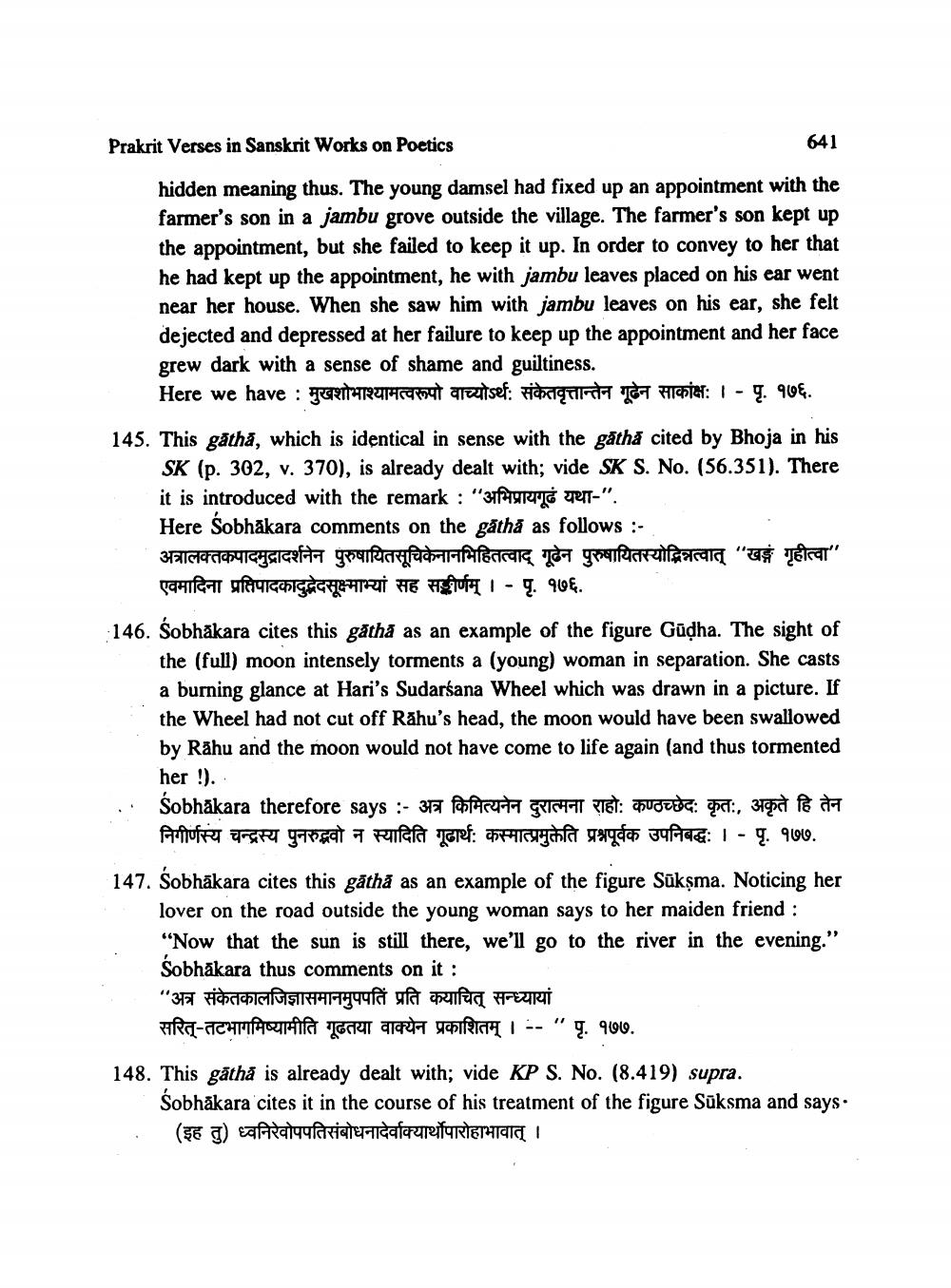________________
Prakrit Verses in Sanskrit Works on Poetics
641
hidden meaning thus. The young damsel had fixed up an appointment with the farmer's son in a jambu grove outside the village. The farmer's son kept up the appointment, but she failed to keep it up. In order to convey to her that he had kept up the appointment, he with jambu leaves placed on his ear went near her house. When she saw him with jambu leaves on his ear, she felt dejected and depressed at her failure to keep up the appointment and her face grew dark with a sense of shame and guiltiness. Here we have : मुखशोभाश्यामत्वरूपो वाच्योऽर्थः संकेतवृत्तान्तेन गूढेन साकांक्ष: । - पृ. १७६.
145. This gatha, which is identical in sense with the gatha cited by Bhoja in his
SK (p. 302, v. 370), is already dealt with; vide SK S. No. (56.351). There it is introduced with the remark : "अभिप्रायगूढं यथा-". Here Sobhākara comments on the găthă as follows :अत्रालक्तकपादमुद्रादर्शनेन पुरुषायितसूचिकेनानभिहितत्वाद् गूढेन पुरुषायितस्योद्भिन्नत्वात् "खङ्गं गृहीत्वा" एवमादिना प्रतिपादकादुद्वेदसूक्ष्माभ्यां सह सङ्कीर्णम् । - पृ. १७६
146. Sobhakara cites this gatha as an example of the figure Gidha. The sight of
the (full) moon intensely torments a (young) woman in separation. She casts a burning glance at Hari's Sudarśana Wheel which was drawn in a picture. If the Wheel had not cut off Rāhu's head, the moon would have been swallowed by Rāhu and the moon would not have come to life again (and thus tormented her !).. Sobhakara therefore says :- अत्र किमित्यनेन दुरात्मना राहो: कण्ठच्छेदः कृतः, अकृते हि तेन
निगीर्णस्य चन्द्रस्य पुनरुद्भवो न स्यादिति गूढार्थ: कस्मात्प्रमुक्तेति प्रश्नपूर्वक उपनिबद्धः । - पृ. १७७. 147. Sobhākara cites this gātha as an example of the figure Sūkşma. Noticing her
lover on the road outside the young woman says to her maiden friend : "Now that the sun is still there, we'll go to the river in the evening." Sobhākara thus comments on it : "अत्र संकेतकालजिज्ञासमानमुपपतिं प्रति कयाचित् सन्ध्यायां सरित्-तटभागमिष्यामीति गूढतया वाक्येन प्रकाशितम् । -- " पृ. १७७.
148. This gātha is already dealt with; vide KP S. No. (8.419) supra.
Sobhākara cites it in the course of his treatment of the figure Süksma and says: (इह तु) ध्वनिरेवोपपतिसंबोधनादेर्वाक्यार्थोपारोहाभावात् ।




